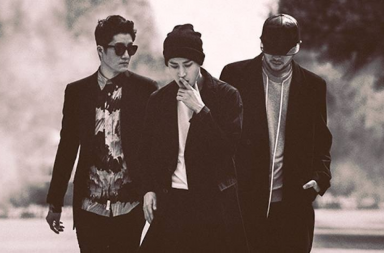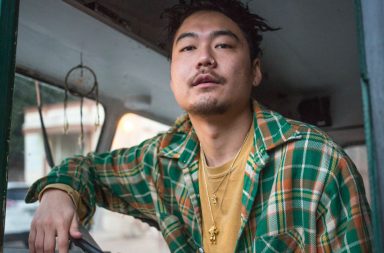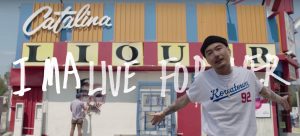 To be re-inscribed and remembered is to defy the parameters of life. “When I die I’m a god, paint me large on the wall,” Dumbfoundead raps in his newest MV “Murals,” and on the stage of Catalina Liquor, we watch a Los Angeles narrative unfold and fade against the enduring mural of his face. As humans live and die, trends come and go, movements bloom and wither – but the specter of Dumbfoundead persists, enshrined on the backdrop of his neighborhood.
To be re-inscribed and remembered is to defy the parameters of life. “When I die I’m a god, paint me large on the wall,” Dumbfoundead raps in his newest MV “Murals,” and on the stage of Catalina Liquor, we watch a Los Angeles narrative unfold and fade against the enduring mural of his face. As humans live and die, trends come and go, movements bloom and wither – but the specter of Dumbfoundead persists, enshrined on the backdrop of his neighborhood.
While the rapper has always drawn from personal life experiences to write lyrics, this MV is a first in featuring a semi-autobiographical storyline to gives scope to his verses. “Murals” follows the life of Latino girl and a Korean boy through the ’90s in Koreatown, using the leads to pay homage to Dumbfoundead’s roots: it’s a nod to the Hispanic culture and Latinos who are part of the K-town area, and to his parents who made their way to the United States through Argentina and Mexico.
We get a montage of the two kids in their daily life, sharing hot Cheetos and playing with water guns. Interwoven are scenes of neighborhood locals (a BMX bro, teenagers drinking on the corner, guys buying drugs). As the kids become a couple they slowly meld into the neighborhood scenes; finally, they kiss, and looting erupts behind them in Catalina Liquor.
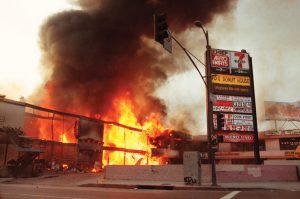 Rewind to 1992. It’s the year of the Los Angeles Riots, known as ‘Sa-I-Gu’ (4-2-9, April 29th) to Koreans. After three white and one Latino police officer are acquitted in court despite evidence of violence against African-American Rodney King, anger in black communities explodes, and five days of rioting and looting spread across South Central Los Angeles. Almost every building in K-town was damaged, with 2,300 stores owned by Koreans completely destroyed. The choice to set “Murals” against Catalina Liquor is not incidental: by the time of the riots, there were 3,320 Korean-American-owned liquor stores in Southern California generating annual sales of $1.8 billion.
Rewind to 1992. It’s the year of the Los Angeles Riots, known as ‘Sa-I-Gu’ (4-2-9, April 29th) to Koreans. After three white and one Latino police officer are acquitted in court despite evidence of violence against African-American Rodney King, anger in black communities explodes, and five days of rioting and looting spread across South Central Los Angeles. Almost every building in K-town was damaged, with 2,300 stores owned by Koreans completely destroyed. The choice to set “Murals” against Catalina Liquor is not incidental: by the time of the riots, there were 3,320 Korean-American-owned liquor stores in Southern California generating annual sales of $1.8 billion.
In an interview with Vice, Dumbfoundead has said:
When I was growing up here the riots and stuff happened…my dad was a part of that, protecting the businesses, but I didn’t understand, at least at that age, about the racial tensions at the time.”
As the number of Korean stores grew rapidly, African-American residents came to be their customers. Yet tension simmered as Koreans began crowding out the black community and refusing to hire African-Americans (the businesses often relied on cheap or free family labor.) In 1991 this resentment reached an apex when Soon Ja-du, a Korean immigrant, shot and killed fifteen-year-old Latasha Harlins in Empire Liquor Market. Harlins had first punched Du after being accused of stealing orange juice.
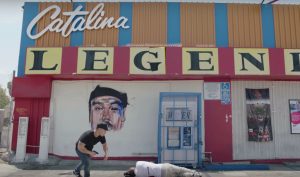 In those days, it was not unusual for Korean store owners to be armed; a growing number of hate crimes – particularly four separate killings of Korean workers by blacks in 1986 – had led many to fear for their lives. The rapper Ice Cube even released a track entitled Black Korea, with lyrics ordering Korean storekeepers to show respect to black people or watch their businesses burn. Come 1992 and the Rodney King trial, Koreans were an easy scapegoat as black rage was deflected from white America onto a vulnerable segment of the immigrant population.
In those days, it was not unusual for Korean store owners to be armed; a growing number of hate crimes – particularly four separate killings of Korean workers by blacks in 1986 – had led many to fear for their lives. The rapper Ice Cube even released a track entitled Black Korea, with lyrics ordering Korean storekeepers to show respect to black people or watch their businesses burn. Come 1992 and the Rodney King trial, Koreans were an easy scapegoat as black rage was deflected from white America onto a vulnerable segment of the immigrant population.
Throughout scenes of “Murals” we see Whites, Blacks, Latinos, and Asians interacting peaceably. These were all the groups involved in ‘Sa-I-Gu,’ although it was the Korean community that ultimately bore the brunt of the riot’s destruction. Korean immigrants realized the need to create stronger ties in the neighborhood and with the rest of the city; from the ashes of K-town came organizations such as the Koreatown Youth and Community Center, the Koreatown Immigrant Workers Alliance (KIWA), and the National Korean-American Service and Education Consortium. And in 2003, it was at the KIWA offices that Dumbfoundead and his friend Kublai Kwon first began to host weekly open mic, Jeet Kune Flow, a space where rappers including Jin, Snacky Chan and Far East Movement came together and performed.
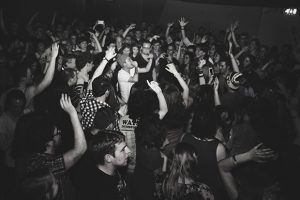 By helping establish an Asian rap scene, Dumbfoundead was also cultivated as an artist and pushed towards recording official songs. While he has collaborated with K-pop artists (Jay Park, Epik High, Kahi), there is a consistency with which he chooses to rap in English about his Korean-American experience, noting that “it’s important that we tell the stories of our people with all the outlets we have here [in Los Angeles].” Even after having toured all across the United States, Dumbfoundead still tells us:
By helping establish an Asian rap scene, Dumbfoundead was also cultivated as an artist and pushed towards recording official songs. While he has collaborated with K-pop artists (Jay Park, Epik High, Kahi), there is a consistency with which he chooses to rap in English about his Korean-American experience, noting that “it’s important that we tell the stories of our people with all the outlets we have here [in Los Angeles].” Even after having toured all across the United States, Dumbfoundead still tells us:
“Paint my face on the side of the liquor store when I die – the one on Catalina up on 8th Street – paint me I wanna be immortalized.”
In the end it’s the blend of Asian, African-American and Latino culture in Los Angeles he identifies with and wishes to be remembered in. “Everything is good when the hood stay quiet,” Dumbfoundead raps, as we eventually see the MV’s Korean protagonist grow old besides his Latino wife and mixed-heritage daughter. The family symbolizes the bridges that have been built between the different cultures and ethnicities in K-town, the healing that has come in spite of horrific violence and destruction. Perhaps it’s even the future he envisions for his own life.
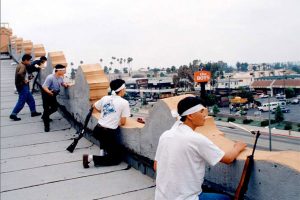 The song fades as the wife and daughter memorialize the death of the protagonist. As the camera pans up and away, on the roof of the bodega stands Dumbfoundead himself, surveying his neighborhood like a god. It could be a scene from the Los Angeles Riots, when Korean store owners like his father armed themselves with handguns and stood vigilant on rooftops to prevent looting. But we know the era Dumbfoundead presides over is the aftermath, in which he has used hip hop to foster a broader, more inclusive Los Angeles.
The song fades as the wife and daughter memorialize the death of the protagonist. As the camera pans up and away, on the roof of the bodega stands Dumbfoundead himself, surveying his neighborhood like a god. It could be a scene from the Los Angeles Riots, when Korean store owners like his father armed themselves with handguns and stood vigilant on rooftops to prevent looting. But we know the era Dumbfoundead presides over is the aftermath, in which he has used hip hop to foster a broader, more inclusive Los Angeles.
Hannah Arendt believed that immortality emerges when a man’s deeds and words are remembered by a community. While Dumbfoundead has used “Murals” to literally painted himself into the foundations of the historical neighborhood, it is for his constant community engagement that he will be immortalized, his legacy living on in the burgeoning K-town rap scene.
MV Rating: 4.5/5
(YouTube, Vice [1][2], Los Angeles Magazine, KCET, The JAMN Blog, Oxford Research Encyclopedias, Los Angeles Times, NPR, Hannah Arendt: The Human Condition, Images via Transparent Agency, Youtube, BBC, Los Angeles Times)
